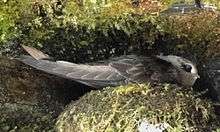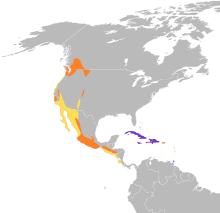American black swift
| American black swift | |
|---|---|
 | |
| Adult black swift on the nest in Shoshone County, Idaho | |
| Scientific classification | |
| Kingdom: | Animalia |
| Phylum: | Chordata |
| Class: | Aves |
| Order: | Apodiformes |
| Family: | Apodidae |
| Genus: | Cypseloides |
| Species: | C. niger |
| Binomial name | |
| Cypseloides niger (Gmelin, 1789) | |
 | |
The American black swift, or more simply black swift (Cypseloides niger), is a name given to birds that are found from northern British Columbia in Canada through the United States and Mexico to Costa Rica and Brazil.[2] They are also found on islands in the West Indies.[3]
In flight, these birds resemble a flying cigar with long slender curved wings. The plumage is mostly a sooty dark gray. There is some contrast between the upper and lower wing. The shoulders are much darker in color than the remaining portion of the wing. They also have short slightly forked tails.
Their breeding habitat is frequently associated with water. The birds most often nest on high cliff faces, either above the ocean surf or behind or next to waterfalls. The nest is made of twigs and moss glued together with mud. They will also use ferns and seaweed if available. The clutch size is one egg, with incubation lasting 23–27 days. Newly hatched young are probably fed multiple times a day, but older nestlings usually only once a day by each parent, most often at dusk. Adults spend the night roosting at or near the nest site.
These birds do migrate out of North America after the breeding season. It remains unclear where most of the birds spend the winter, although some of the birds have been tracked as far south as Brazil, migrating there from Colorado. Some of the birds in the West Indies appear to be permanent residents. They are late spring migrants into the breeding range, with Colorado breeders not arriving until the very end of May into June. Large flocks of migrants are occasionally seen spring and fall, but only very rarely far south of the U.S. breeding range.
American black swifts live on the wing, foraging in flight. They eat flying insects, primarily flying ants and beetles, often foraging in small groups.
Status and distribution
North America
Fewer than 150 black swift breeding sites are known in the United States, with 108 (as of July 2012) known from Colorado.[4] These include:
- In Alberta: next to waterfall in Johnson Canyon, Banff National Park. (declining, given extra protection as of August 2018).[4][5]
- In California: the Santa Cruz coast (where it is declining); Berry Creek Falls; Burney Falls State Park; Yosemite, Sequoia, and Kings Canyon National Parks; the San Bernardino Mountains; and the San Jacinto Mountains.[4]
- In Colorado: Box Canyon near Ouray,[6] Hanging Lake,[7] Hawk Creek Falls, Falls Creek Falls, and Niagara and Cataract Gulches.[4]
- In New Mexico: Jemez Falls.[4]
- In Utah: Stewart Falls.[4]
- In Washington: Semiahmoo Bay[4]
References
- ↑ BirdLife International (2012). "Cypseloides niger". IUCN Red List of Threatened Species. Version 2013.2. International Union for Conservation of Nature. Retrieved 26 November 2013.
- ↑ Lofholm, Nancy (3 March 2012). "Birders take black swift mystery under their wing". The Denver Post.
- ↑ Wiggins, David A. (2004). "Black Swift (Cypseloides niger). A Technical Conservation Assessment" (PDF). USDA Forest Service, Rocky Mountain Region.
- 1 2 3 4 5 6 7 Levad, Rich (2007). "The Coolest Bird" (PDF). The American Birding Association.
- ↑ Staff writers (2018-08-17). "Unofficial trail in 'secret cave' area of Johnston Canyon closed by Parks Canada to protect unique birds". CBC News. Retrieved 2018-08-19.
- ↑ "Ouray, Colorado: Birding". Ouray Chamber Resort Association.
- ↑ "Audubon IBAs: Hanging Lake". Archived from the original on 14 March 2012.
External links
| Wikimedia Commons has media related to Cypseloides niger. |
| Wikispecies has information related to Cypseloides niger |
- Black swift Stamps from the Lesser Antilles: Dominica at bird-stamps.org
- American black swift photo gallery at VIREO (Drexel University)
- BirdLife species factsheet for Cypseloides niger
- "Black swift media". Internet Bird Collection.
- Interactive range map of Cypseloides niger at IUCN Red List maps
- Audio recordings of American black swift on Xeno-canto.
